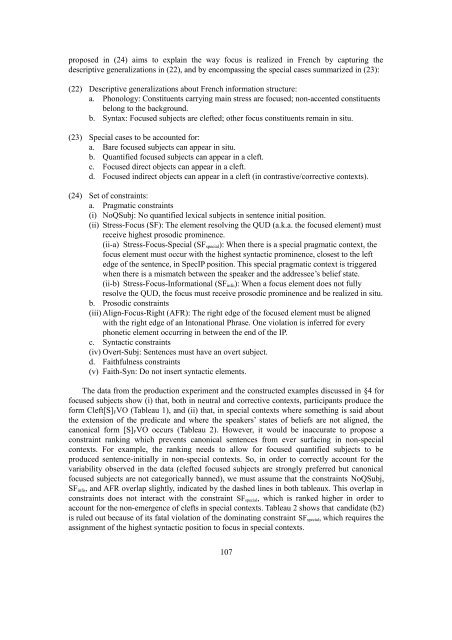Empirical Issues in Syntax and Semantics 9 (EISS 9 ... - CSSP - CNRS
Empirical Issues in Syntax and Semantics 9 (EISS 9 ... - CSSP - CNRS
Empirical Issues in Syntax and Semantics 9 (EISS 9 ... - CSSP - CNRS
Create successful ePaper yourself
Turn your PDF publications into a flip-book with our unique Google optimized e-Paper software.
proposed <strong>in</strong> (24) aims to expla<strong>in</strong> the way focus is realized <strong>in</strong> French by captur<strong>in</strong>g the<br />
descriptive generalizations <strong>in</strong> (22), <strong>and</strong> by encompass<strong>in</strong>g the special cases summarized <strong>in</strong> (23):<br />
(22) Descriptive generalizations about French <strong>in</strong>formation structure:<br />
a. Phonology: Constituents carry<strong>in</strong>g ma<strong>in</strong> stress are focused; non-accented constituents<br />
belong to the background.<br />
b. <strong>Syntax</strong>: Focused subjects are clefted; other focus constituents rema<strong>in</strong> <strong>in</strong> situ.<br />
(23) Special cases to be accounted for:<br />
a. Bare focused subjects can appear <strong>in</strong> situ.<br />
b. Quantified focused subjects can appear <strong>in</strong> a cleft.<br />
c. Focused direct objects can appear <strong>in</strong> a cleft.<br />
d. Focused <strong>in</strong>direct objects can appear <strong>in</strong> a cleft (<strong>in</strong> contrastive/corrective contexts).<br />
(24) Set of constra<strong>in</strong>ts:<br />
a. Pragmatic constra<strong>in</strong>ts<br />
(i) NoQSubj: No quantified lexical subjects <strong>in</strong> sentence <strong>in</strong>itial position.<br />
(ii) Stress-Focus (SF): The element resolv<strong>in</strong>g the QUD (a.k.a. the focused element) must<br />
receive highest prosodic prom<strong>in</strong>ence.<br />
(ii-a) Stress-Focus-Special (SF special ): When there is a special pragmatic context, the<br />
focus element must occur with the highest syntactic prom<strong>in</strong>ence, closest to the left<br />
edge of the sentence, <strong>in</strong> SpecIP position. This special pragmatic context is triggered<br />
when there is a mismatch between the speaker <strong>and</strong> the addressee’s belief state.<br />
(ii-b) Stress-Focus-Informational (SF <strong>in</strong>fo ): When a focus element does not fully<br />
resolve the QUD, the focus must receive prosodic prom<strong>in</strong>ence <strong>and</strong> be realized <strong>in</strong> situ.<br />
b. Prosodic constra<strong>in</strong>ts<br />
(iii) Align-Focus-Right (AFR): The right edge of the focused element must be aligned<br />
with the right edge of an Intonational Phrase. One violation is <strong>in</strong>ferred for every<br />
phonetic element occurr<strong>in</strong>g <strong>in</strong> between the end of the IP.<br />
c. Syntactic constra<strong>in</strong>ts<br />
(iv) Overt-Subj: Sentences must have an overt subject.<br />
d. Faithfulness constra<strong>in</strong>ts<br />
(v) Faith-Syn: Do not <strong>in</strong>sert syntactic elements.<br />
The data from the production experiment <strong>and</strong> the constructed examples discussed <strong>in</strong> §4 for<br />
focused subjects show (i) that, both <strong>in</strong> neutral <strong>and</strong> corrective contexts, participants produce the<br />
form Cleft[S] F VO (Tableau 1), <strong>and</strong> (ii) that, <strong>in</strong> special contexts where someth<strong>in</strong>g is said about<br />
the extension of the predicate <strong>and</strong> where the speakers’ states of beliefs are not aligned, the<br />
canonical form [S] F VO occurs (Tableau 2). However, it would be <strong>in</strong>accurate to propose a<br />
constra<strong>in</strong>t rank<strong>in</strong>g which prevents canonical sentences from ever surfac<strong>in</strong>g <strong>in</strong> non-special<br />
contexts. For example, the rank<strong>in</strong>g needs to allow for focused quantified subjects to be<br />
produced sentence-<strong>in</strong>itially <strong>in</strong> non-special contexts. So, <strong>in</strong> order to correctly account for the<br />
variability observed <strong>in</strong> the data (clefted focused subjects are strongly preferred but canonical<br />
focused subjects are not categorically banned), we must assume that the constra<strong>in</strong>ts NoQSubj,<br />
SF <strong>in</strong>fo , <strong>and</strong> AFR overlap slightly, <strong>in</strong>dicated by the dashed l<strong>in</strong>es <strong>in</strong> both tableaux. This overlap <strong>in</strong><br />
constra<strong>in</strong>ts does not <strong>in</strong>teract with the constra<strong>in</strong>t SF special , which is ranked higher <strong>in</strong> order to<br />
account for the non-emergence of clefts <strong>in</strong> special contexts. Tableau 2 shows that c<strong>and</strong>idate (b2)<br />
is ruled out because of its fatal violation of the dom<strong>in</strong>at<strong>in</strong>g constra<strong>in</strong>t SF special , which requires the<br />
assignment of the highest syntactic position to focus <strong>in</strong> special contexts.<br />
107











